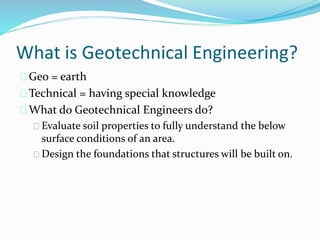The Definitive Guide for Geotheta
The Definitive Guide for Geotheta
Blog Article
Geotheta Things To Know Before You Get This
Table of ContentsSee This Report on GeothetaUnknown Facts About GeothetaThe Of GeothetaNot known Factual Statements About Geotheta
They work together with civil designers, structural engineers, architects, and various other specialists to integrate geotechnical considerations into the general project design and building and construction process. This requires efficient team effort, coordination, and interaction to make certain that the geotechnical facets align with the job purposes and meet governing needs.Mining & Materials Engineering: Concepts of exploration, penetration prices, and factors affecting the selection of drilling method. Attributes of explosives, shooting systems and blast patterns. Blasting methods in surface and below ground operations. Unique blasting strategies at excavation perimeters. Resonance and noise control. Mechanical and continuous techniques to fragmentation, including longwall shearing and fullface boring.
Integrated evaluation of fragmentation and comminution operations. Supplied by: Mining & Products Design.
The Greatest Guide To Geotheta
Bachelor's level programs in civil, geotechnical, geological, and ecological engineering normally last 4 years and include general education and learning training courses in English, social science, and the humanities, in addition to courses in sophisticated maths, structural geology, and fluid mineralogy. (https://es.quora.com/profile/Ian-Hammond)
Geotechnical design includes the assessment of the soil and rock problems at a certain site, and their ramifications for the advancement of that site. As a lot of structures depend on the ground for assistance, it is without surprise that a detailed understanding of the ground conditions, and the suitability of foundation systems, are important to the long-term security and performance of the structure or framework.
Specialising in the investigation of geological developments and ground behavior, geotechnical engineers perform clinical investigations and testing to understand the influence these geological formations might carry the style and building of building, civil and framework projects. This experience is important for the layout and building of buildings, roads, passages, dams, bridges, and supply of water and sewer system.
The geotechnical team at Douglas Allies consistently seek advice from designers, style engineers, programmers, and contractors to make referrals on layout and development propositions to make certain that the built frameworks are appropriately designed for the ground conditions. As an example, the style of footing systems requires to think about the weight of the framework, the capacity of the ground to sustain that weight along with activity resistances and effective building and construction.
Geotheta - Truths
This job is considerably streamlined by the use our Douglas Map geospatial platform which makes this information easily easily accessible in a simple to utilize internet browser user interface. A geotechnical engineer will certainly route the exploration of boreholes and examination pits to accumulate dirt and various other examples, and also assess surface functions and ground direct exposures to develop a geotechnical version of the subsurface problems.
Depending upon the job kind and ground conditions experienced, laboratory screening might amongst other things assess stamina, compressibility, reactivity and/or leaks in the structure of dirt and rock examples. After this data is gathered and looked at, the outcomes are utilized for a geotechnical model of the site, which is commonly presented as areas throughout the site.

A geotechnical examination naturally can just analyze the ground problems at the locations pierced or dug deep into. All-natural variants in dirt and rock conditions can happen throughout a site and in between examination areas. It is therefore great practice that the geotechnical engineer be kept throughout building and construction of the task to provide on-site confirmation that the ground problems encountered are regular with the expectations and recommendations provided in the geotechnical examination record.
See This Report on Geotheta
Geotechnical designers use their comprehensive knowledge of soil and rock to evaluate risk and resolve troubles on diverse facilities projectsGeotechnical design is a specialist branch of civil design which takes a look at the behaviour of earth products and the application of soil and rock technicians. Tailings Engineer. As a geotechnical engineer, you will certainly analyze the physical, mechanical and chemical residential or commercial properties of soil and rock in order to design structures, preserving frameworks click site and earthworks
Geotechnical design is carefully linked to and overlaps with, both design geology and ground engineering - https://canvas.instructure.com/eportfolios/3071866/Home/Why_Geotechnical_Engineers_Are_Essential_for_Your_Construction_Projects. It's possible to be experts in geotechnics or help a geotechnical firm but be referred to as a design rock hound or a ground designer. As a geotechnical engineer, you'll require to: construct and preserve partnerships with clients and various other specialists associated with the website, throughout each projectmaintain safety standards on website bear in mind expense implications when you make recommendationsstudy geological maps and airborne photos from a series of sources and from different time periodsexamine construction prepares to see just how viable they are based upon your understanding of the siteinvestigate threats or geological dangers for the sitesearch for ecologically delicate functions, such as landfill start to create valid and interpretive ground modelsplan field investigationsdrill and analyse examples of bedrock, soil, groundwater and added products monitor other experts on sitesolve technological issues as they develop, such as unforeseen frameworks at drill sitesmonitor problems during and after building to make certain structures are steady in the brief and lengthy termadding data collected on site to your first researchcreating geotechnical calculations, drawings, and 2 or three-dimensional computer designs interpreting the datamaking recommendations concerning the suggested usage of the site

Report this page